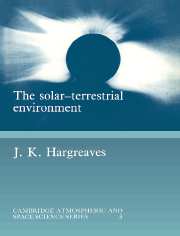 The Solar-Terrestrial Environment
The Solar-Terrestrial Environment Book contents
- Frontmatter
- Contents
- Preface
- 1 The Earth in space
- 2 The physics of geospace
- 3 Techniques for observing geospace
- 4 The neutral atmosphere
- 5 The solar wind and the magnetosphere
- 6 Principles of the ionosphere at middle and low latitudes
- 7 Ionospheric phenomena at middle and low latitudes
- 8 The ionosphere at high latitude
- 9 Magnetospheric waves
- 10 Technological application of geospace science
- Index
8 - The ionosphere at high latitude
Published online by Cambridge University Press: 29 January 2010
- Frontmatter
- Contents
- Preface
- 1 The Earth in space
- 2 The physics of geospace
- 3 Techniques for observing geospace
- 4 The neutral atmosphere
- 5 The solar wind and the magnetosphere
- 6 Principles of the ionosphere at middle and low latitudes
- 7 Ionospheric phenomena at middle and low latitudes
- 8 The ionosphere at high latitude
- 9 Magnetospheric waves
- 10 Technological application of geospace science
- Index
Summary
…he says in his sixth book that he observed…men of fire in heaven, who fought with lances, and who by this terrifying spectacle foretold the fury of the wars which followed. Yet I was with him in the same town, and I protest…that I saw nothing similar to his description, but only an appearance which is sufficiently common, in the form of pavilions in the sky flaming up and fading out again, as is usual with such meteors.
La Mothe le Vayer, 78th letter De la Crédulité (17th century). Quoted by A. Angot in The Aurora Borealis, (1896)Dynamics of the polar ionosphere
Chapter 5 described how the magnetosphere circulates as two regions, an inner one rotating daily with the Earth, and an outer one circulating under the influence of the solar wind. The polar ionosphere is connected by the geomagnetic field-lines to this outer region, and – since the field-lines are (almost) equipotentials – its circulation is essentially a projection of that of the outer magnetosphere.
F-region circulation
In the F region, where the ion–neutral collision frequency is small relative to the gyrofrequency, the plasma moves with the magnetic field-lines. Alternatively, we can say that the electric field which the solar wind generates across the magnetosphere (Section 5.5.3) is mapped into the F region along the equipotential field-lines. The polar-cap electric field so created (as measured by a stationary observer) then acts as the driving force for the F-region plasma (Sections 2.3.7 and 6.5.4). The integral of the electric field gives the total electric potential across the polar cap.
- Type
- Chapter
- Information
- The Solar-Terrestrial EnvironmentAn Introduction to Geospace - the Science of the Terrestrial Upper Atmosphere, Ionosphere, and Magnetosphere, pp. 312 - 363Publisher: Cambridge University PressPrint publication year: 1992


